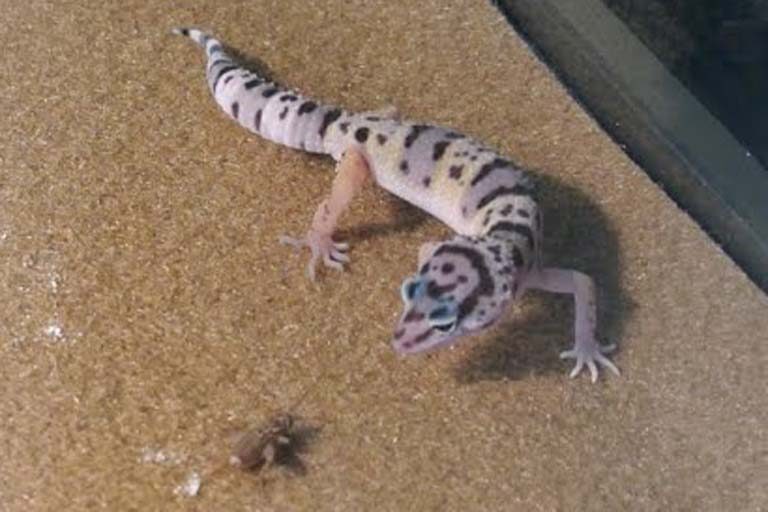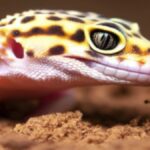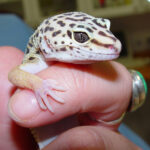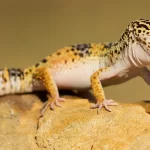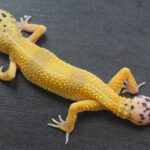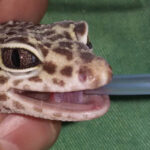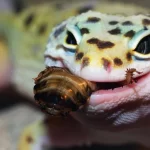Mite infestations (ascariasis and ‘black skin disease’) are commonly seen in reptiles, including Leopard geckos, and can spread from one reptile to others.
Introduction to Leopard gecko mites
Mites are small arthropods belonging to the class Arachnida (the same class as spiders) and, together with ticks, to the subclass Acari. They are eight-legged organisms that inhabit the outside skin of many reptile species.
These tiny (only up to a few millimetres in length) parasites attach themselves to their host and bore through the skin. Most of them are haematophagous — meaning that they suck blood. Although having a symbiotic relationship with some reptile species, their presence can result in significant blood loss, loss of appetite a weakened immune system and various degrees of skin irritations.
Mites can also transmit diseases from one host to another and affect the overall health and appearance of reptiles.
Mite infestations in reptiles
With more than 250 different mite species that can infest reptiles, there are only a couple of ones that are worth mentioning. They are the snake mite (Ophionyssus natricis), the common lizard mite (Hirstiella trombidiformis) and the larvae of the trombiculid mite (also known as chiggers). Snake mites (the most common of them all) can infest lizards and lizard mites can infest snakes.
Snake mites, lizard mites and chiggers survive by sucking the blood of reptiles.
Although mites are commonly found in wild reptiles, they can cause severe problems in pet reptiles. Because of stress and the space limitations of reptile enclosures (when compared with the open spaces of the wilderness), mites tend to proliferate and concentrate more on pet reptiles.
Mite infestations are more commonly a problem in unhygienic enclosures, where poor husbandry is practised, with recent acquisitions and/or (wild-caught) imports.
Mites can also infest pet Leopard geckos. Apart from seeing the mites, signs of mite infestations in Leopard geckos include:
- damaged skin
- excessive soaking behaviour
- loss of appetite
- weight loss / poor body condition
- skin shedding problems (dysecdysis)
- the build-up of white dust at the bottom of the enclosure
Mite infestations are usually quite obvious. While still on the animal, they are often seen with the naked eye or better, under magnification. Depending on the gender and age, snake mites are either black or tan.
Lizard mites and chiggers are usually red to orange in colour. When present, non-attached mites can often be seen as little moving specs on the skin of Leopard geckos. Attached ones can be found around the eyelid folds, ear openings, axillae, cloacal area (the vent) and other skin folds. Drowned mites are also often seen in the affected animal’s water container.
Affected skin, often areas surrounding the joints, may result in hyperpigmentation (‘black’ dermatitis), hence the name ‘black skin disease’.
Excessive soaking behaviour, loss of appetite, poor body condition and skin shedding problems also warrants a proper, close-up inspection for mites.
Also see
Skin shedding problems in Leopard geckos
Leopard gecko soaking — warning signs
Origin of mites
Mites will breed and lay eggs in small cracks and crevices. Once they have established themselves, they will quickly spread to other enclosures and other animals. They also spread easily from one Leopard gecko to another.
Mites commonly enter an enclosure or collection attached on newly acquired reptiles that have not been quarantined properly. Facilities that are unhygienic and dirty and collections containing imported and/or wild-caught reptiles are more likely to be affected by mites.
The best way to prevent a mite infestation is by preventing it from entering a collection in the first place. This is done by purchasing healthy-looking Leopard geckos from reputable breeders with clean, mite-free facilities, avoiding wild-caught Leopard geckos and by quarantine.
Because mites might not be evident at first (especially in milder cases), all newly acquired Leopard geckos should be quarantined until they are mite-free for at least 6 weeks. To include the identification of other Leopard gecko diseases, the quarantine period should be at least 3 months.
Quarantine/isolation principles should also be applied for Leopard geckos that have been diagnosed with mite infestations (see Treatment of mite infestations in Leopard geckos below).
During the quarantine/isolation period, inspections should include close visualisation of the Leopard gecko’s skin, substrate and water container. The final quarantine inspection should preferably be done by a reptile-friendly veterinarian or herpetologist.
Also see
Leopard gecko quarantine: Why, how long?
Treatment of mites in Leopard geckos
To get rid of mites, affected Leopard geckos and their enclosures need to be treated. In severe infestations, the room where the Leopard geckos have been housed in and other reptile containers will also need to be treated for mites. Mites will often return when effective treatment was not done efficiently.
The first thing to do after mites have been spotted is to isolate the entire enclosure from the rest of a reptile collection. It should be assumed that everything inside the enclosure is infested with mites and/or contains mite eggs.
All affected Leopard geckos should be placed in separate, large enough, plastic containers with a paper-based substrate and as little enclosure furniture as possible. This will make it more difficult for mites to hide away and breed. The supply of food and mineral and vitamin supplements should continue as usual.
Mites can easily be identified in simple, minimalistic enclosures, e.g. during quarantine. It will be more difficult for mites to hide and breed in plastic containers and containers with paper substrates. Image Korean Gardener (CC BY YouTube)
Treating the environment
When they are not feeding, mites spend a lot of their time reproducing in away from their hosts — mainly in small, dark places like holes, cracks, crevices, under enclosure decoration/furniture and under the substrate.
Some mites can survive without a meal for up to 19 days before they will die from starvation. Even then, mite eggs can still hatch after adults have been eradicated. These factors make it very tricky to get rid of mite infestations.
After Leopard geckos have been removed, the entire enclosure and all its original furniture need to be cleaned out, treated for mites and properly disinfected. The enclosure should never be treated while there are still animals inside.
The original substrate should be removed and discarded in a plastic bag. Vacuuming, focussing on the corners and crevices, will help to remove mite eggs. The enclosure, enclosure furniture and equipment need to be cleaned to get rid of dirt. Normal soap and water can be used. The cleaning step might help drown some mites in the process.
After cleaning, all surfaces (including heat pads and lighting) need to be treated with an effective ascaricide (a group of chemical drugs that kills mites and ticks). Drenching will allow smaller cracks and crevices to be filled as well but fogging, sprays and powders are also often used.
Because most acaricides will only kill the adult stages of mites (and not the larvae and eggs), time needs to be given for eggs to hatch and larvae to turn into adults. For this reason, treatment needs to be done weekly for at least four (but up to six) consecutive weeks.
Effective ascaricides that can be used on contact surfaces include pyrethroids, pyrethrins, fipronil and carbamates. Products that are safe to use by humans and that are readily available include Frontline spray (fipronil) and F10 antiseptic spray with insecticide (synthetic pyrethrin).
After the treatment of mites (i.e. a couple of weeks down the line), the enclosure and enclosure furniture needs to be disinfected. Disinfection will not kill mites, but is more to kill potentially harmful organisms that may be spread around by the mites. By this time, all mites should be eradicated. To prevent any residing poison from affecting Leopard geckos, treated items should be properly washed, rinsed and ventilated before their return.
Other ways to kill mites in the environment include heat treatment (temperatures exceeding the 55 ºC / 131º F) and biocontrol. Early studies have shown that predatory mites (Stratiolaelaps scimitus – marketed as Hypoaspis miles and Stratiolaelaps eruditus) were effective in eradicating mite infestations and in various scenarios(28). Further investigation with this regard is still underway.
In severe cases, and/or where multiple reptiles are being housed in the same room, it is often indicated that the entire room gets treated. When this is the case, it is best to consult the services of pest control professionals.
Treating Leopard geckos with mites
Apart from treating the environment, mites that are still on the Leopard gecko also needs to be treated. Treatment should be done while a Leopard gecko is being isolated. Options include manual removal of mites, water baths, coating with oil, spraying, wiping, shampooing or dusting with ascaricides and the administration of antiparasitic medications (e.g. ivermectin). Debilitated Leopard geckos should be stabilised before treatment with ascaricides and antiparasitics are used.
The majority of treatment options include the use of chemotherapeutics (i.e. ascaricides, antiparasitic medication and antiseptics). Although they are considered necessary when dealing with a problematic condition such as mite infestations, their long term effects on reptiles (especially Leopard geckos) are not completely understood. Their use and safety should be considered on a per-patient basis.
Treatments such as water baths and manual removal of mites are relatively safe and can be attempted at home. When proven inefficient, individualised advice and treatment options can be obtained by consulting with a reptile-friendly veterinarian or herpetologist. They will also most likely be able to supply the correct treatment products.
Leopard geckos can be bathed/soaked once a day in chin-deep water for 30 minutes at a time(23). The water temperature needs to be similar to that of the enclosure (i.e. 25–30 ºC / 77–86 ºF(23), use a thermometer) and the soaking container must be deep enough to prevent escape. This will cause the mites to detach and drown. Care needs to be taken not to allow the head of the Leopard gecko to go below the level of the water.
Mites already on, or crawling to, the head of Leopard gecko can be manually removed by rinsing the head and neck and/or rubbing them with a cotton-tipped swab dipped in mineral oil. Some authors recommend adding povidone-iodine (e.g. Bethadine) to the bathwater to form a weak solution(27).
Bethadine will act as a topical antiseptic that will help to disinfect bite wounds. Bethadine or F10 Germicidal Barrier ointment can also be applied to open wounds with a cotton-tipped swab. If Bethadine has been added to the water, the Leopard gecko should be soaked afterwards in fresh water to rinse it off. Soaked/rinsed Leopard geckos should be dried before returned to their enclosures.
Although messy, mineral oil, olive oil or baby oil are popularly used to treat mites on Leopard geckos. Apart from being used with a cotton-tipped swop to remove mites manually, oils can also be applied as a coating.
Oil coating is a recommended way to treat small and delicate reptiles. Care must be taken not to get oil inside the Leopard gecko’s eyes. The oil layer needs to be washed off by bathing with a mild soap the next day and can be applied once a week(23).
Topical treatments in the form of spraying, wiping, shampooing and dusting Leopard geckos and other reptiles are also described.
Effective acaricides for this purpose include diluted concentrations of pyrethroids (e.g. 0.35% Resmethrin spray or shampoo and 10% Permethrin diluted to a 1% solution) and pyrethrins (e.g. 0.09% pyrethrin spray). Pyrethroids are safer to use than pyrethrins. Topical treatments might have to be repeated for 2 to 3 times allowing at least 10 days in between(23).
When using topical treatments caution must be taken during the skin shedding process. There seems to be an increased permeability of the skin during the growth and shedding phase. Snakes sprayed with anti-mite medications at this time appear much more susceptible to such toxins than those sprayed at other times(55).
Ivermectin (e.g. Ivomec) can also be used to kill attached mites on Leopard geckos. It is an antiparasitic medicine that can be given either per mouth or as an injection under the skin. It can also be used as an external contact spray or environmental spray by mixing it with water. Treatment should preferably be done under the guidance of a reptile-friendly veterinarian or herpetologist – which will also be able to help with the correct equipment, technique and obtaining the medicine. In addition to treating mites, ivermectin is also used to treat nematodes (roundworms) in some reptiles.
Treatment with ivermectin is done initially and then repeated after 2 weeks (0.2mg/kg)(23). In order to prevent, or reduce the incidence of skin discolouration at the injection site, oral formulations should be used, or injections can be diluted with propylene glycol. Ivermectin is used extra-labelly in reptiles and side effects include lethargy, inappetence, nervous signs (occasionally) and death (rarely)(23).
To create a contact or environmental spray, 5-10 mg injectable ivermectin is added to one litre of water. It can be sprayed directly on the skin or the inside of the enclosure at intervals of 4 to 5 days for up to 28 days(23).
Conclusion
Mite infestations in Leopard geckos are often seen in collections which came in contact with wild reptiles and unhygienic facilities. Mites can be eradicated, but it is tricky to do so.

